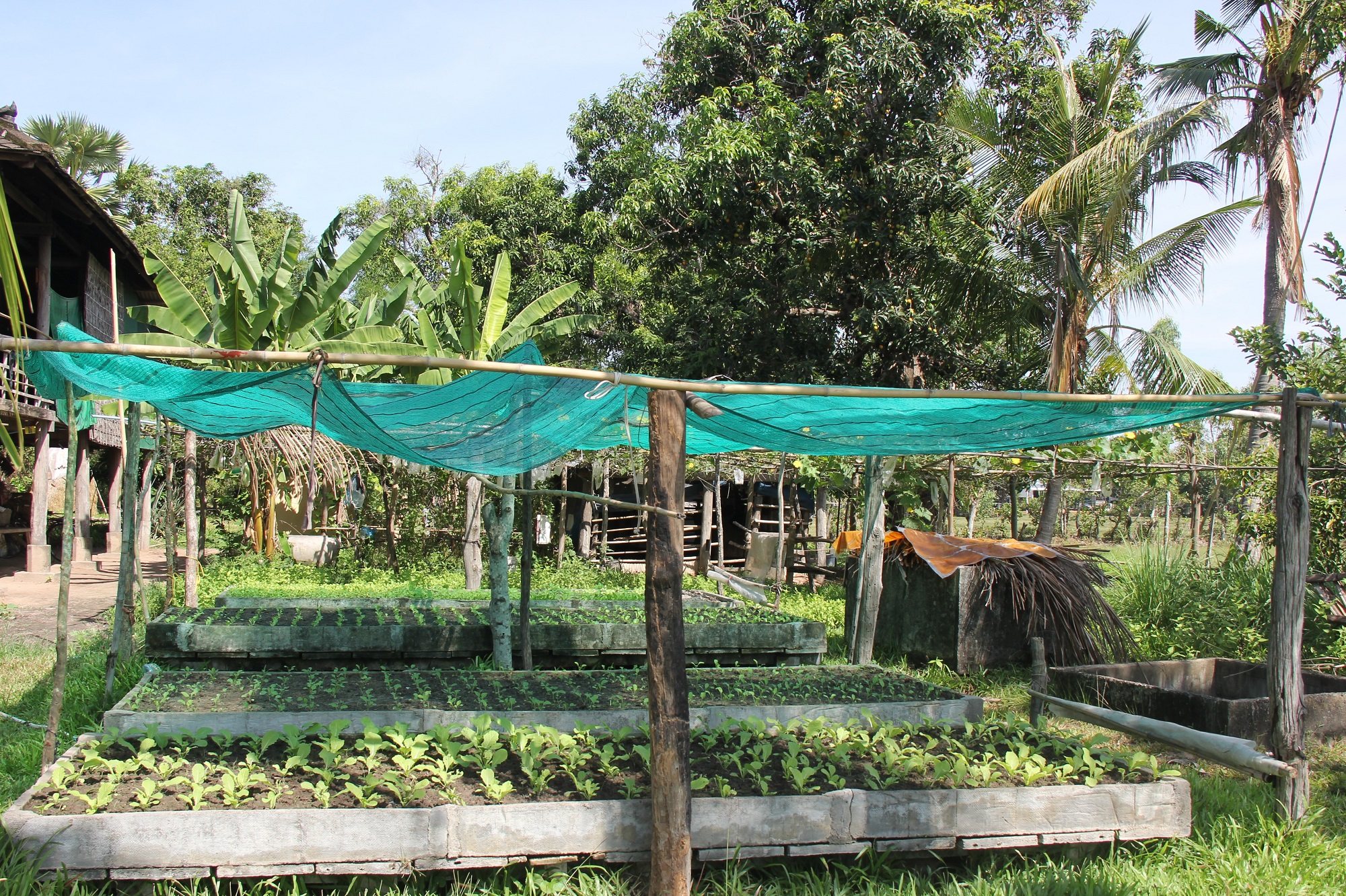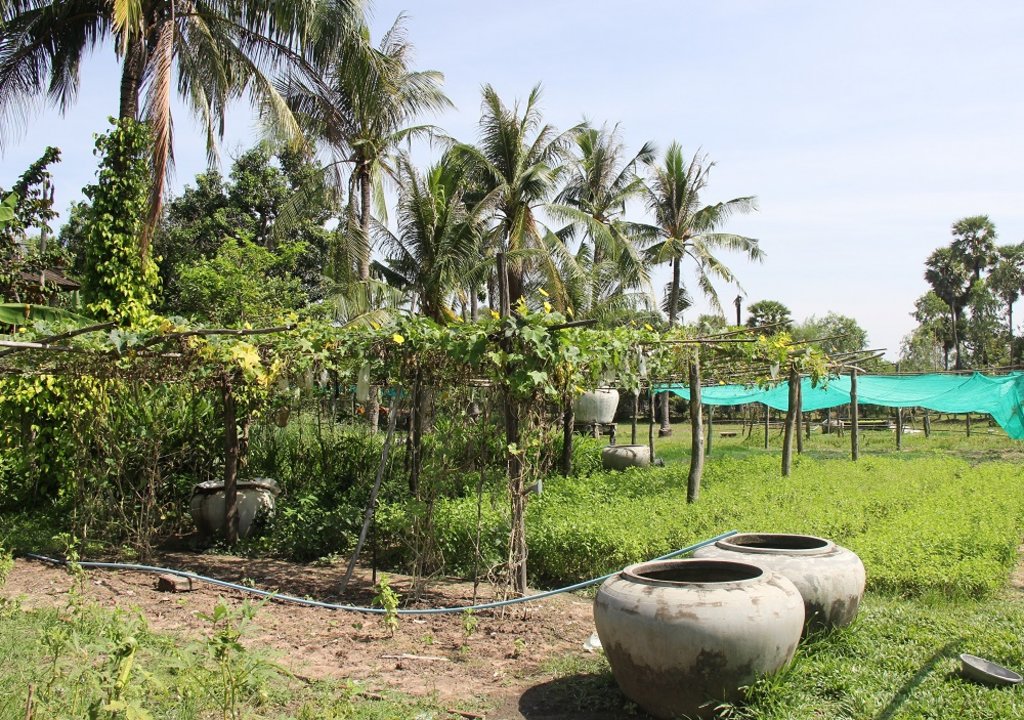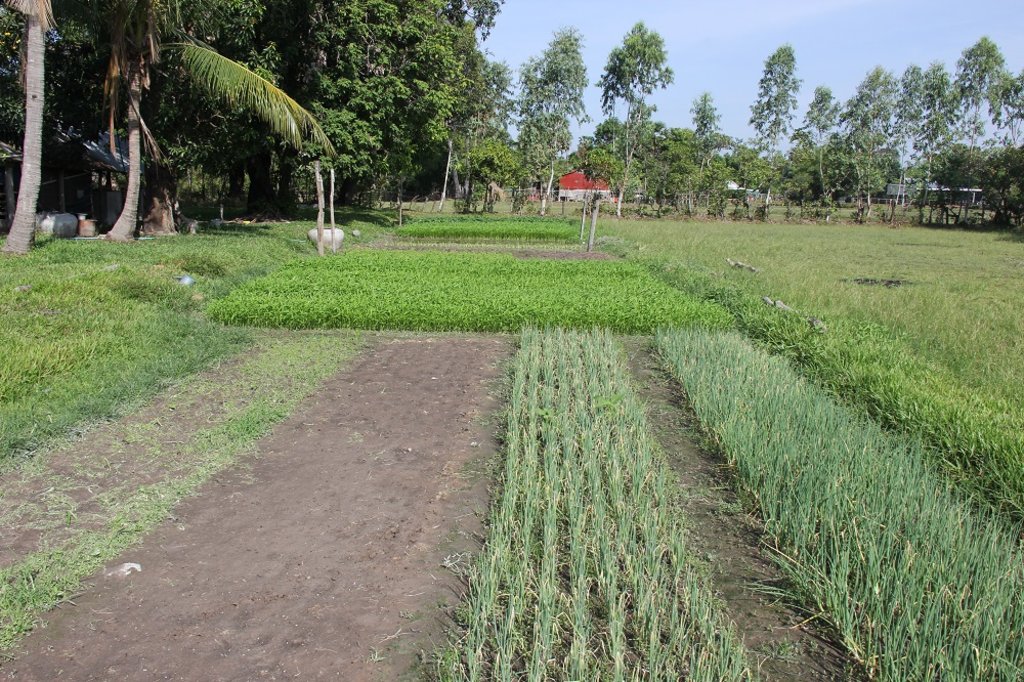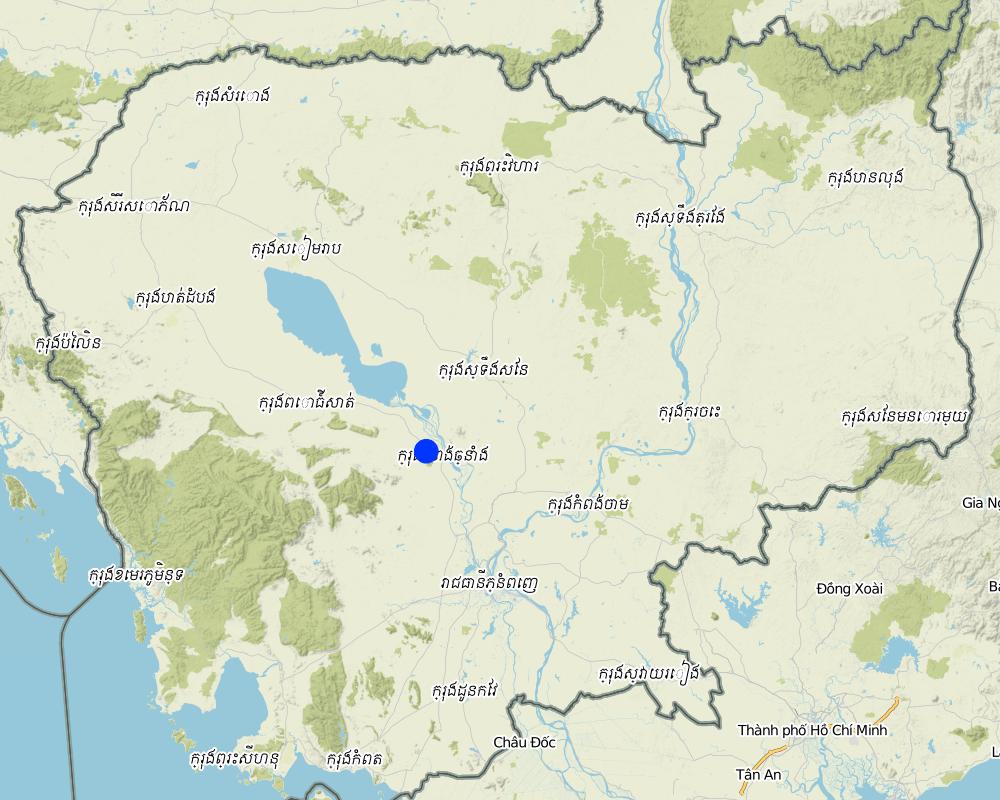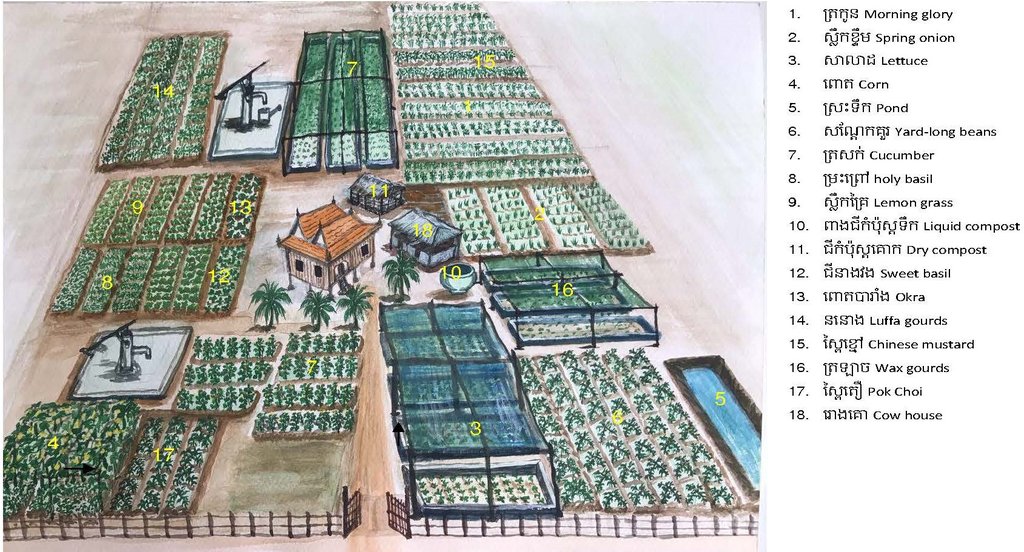ការដាំបន្លែសរីរាង្គតាមគោលការណ៍ធម្មជាតិដើម្បីបង្កើនសេដ្ឋកិច្ចគ្រួសារ និងរក្សាគុណភាពដី [Cambodia]
- Creation:
- Update:
- Compiler: Sok Pheak
- Editors: Sophea Tim, Navin Chea
- Reviewers: Nicole Harari, SO Than, Stephanie Jaquet, Ursula Gaemperli
កសិដ្ឋានបន្លែសរីរាង្គ
technologies_3151 - Cambodia
- Full summary as PDF
- Full summary as PDF for print
- Full summary in the browser
- Full summary (unformatted)
- ការដាំបន្លែសរីរាង្គតាមគោលការណ៍ធម្មជាតិដើម្បីបង្កើនសេដ្ឋកិច្ចគ្រួសារ និងរក្សាគុណភាពដី: April 19, 2018 (inactive)
- ការដាំបន្លែសរីរាង្គតាមគោលការណ៍ធម្មជាតិដើម្បីបង្កើនសេដ្ឋកិច្ចគ្រួសារ និងរក្សាគុណភាពដី: April 23, 2018 (inactive)
- ការដាំបន្លែសរីរាង្គតាមគោលការណ៍ធម្មជាតិដើម្បីបង្កើនសេដ្ឋកិច្ចគ្រួសារ និងរក្សាគុណភាពដី: Maart 1, 2019 (public)
View sections
Expand all Collapse all1. General information
1.2 Contact details of resource persons and institutions involved in the assessment and documentation of the Technology
Key resource person(s)
land user:
ទៀវ ឆាត
(+855) 975070417
កសិករ
ភូមិថ្មរាប ឃុំពង្រ ស្រុករលាផ្អៀរ ខេត្តកំពង់ឆ្នាំង
Cambodia
អនុប្រធានផ្នែកក្សេត្រសាស្ត:
ឈឹម ប៊ុនលាង
(+855) 77797324
Chhimbuleng@gmail.com
ការិយាល័យកសិកម្ម រុក្ខាប្រមាញ់ និងនេសាទសស្រុករលាផ្អៀរ
ភូមិព្រៃពួជ ឃុំជ្រៃបាក់ ស្រុករលាផ្អៀរ ខេត្តកំពង់ឆ្នាំង
Cambodia
អនុប្រធានការិយាល័យផ្សព្វផ្សាយ:
ខឹម សំបូរ
(+855) 978862028
មន្ទីរកសិកម្ម រុក្ខាប្រមាញ់ និងនេសាទខេត្តកំពង់ឆ្នាំង
ភូមិទី១ សង្កាត់ខ្សាម ក្រុងកំពង់ឆ្នាំង ខេត្តកំពង់ឆ្នាំង
Cambodia
ប្រធានការិយាល័យកសិកម្ម រុក្ខាប្រមាញ់ និងនេសាទស្រុកទឹកផុស:
កែវ សែ
(+855) 12642635
ការិយាល័យកសិកម្ម រុក្ខាប្រមាញ់ និងនេសាទស្រុកទឹកផុស
ភូមិស្រែតាជៃ ឃុំអភវិឌ្ឍន៍ ស្រុកទឹកផុស ខេត្តកំពង់ឆ្នាំង
Cambodia
Name of project which facilitated the documentation/ evaluation of the Technology (if relevant)
Scaling-up SLM practices by smallholder farmers (IFAD)Name of the institution(s) which facilitated the documentation/ evaluation of the Technology (if relevant)
Royal University of Agriculture (RUA) - Cambodia1.3 Conditions regarding the use of data documented through WOCAT
When were the data compiled (in the field)?
23/05/2017
The compiler and key resource person(s) accept the conditions regarding the use of data documented through WOCAT:
Ja
1.4 Declaration on sustainability of the described Technology
Is the Technology described here problematic with regard to land degradation, so that it cannot be declared a sustainable land management technology?
Nee
2. Description of the SLM Technology
2.1 Short description of the Technology
Definition of the Technology:
ការដាំបន្លែសរីរាង្គបែបចម្រុះដោយប្រើប្រាស់ជីធម្មជាតិ និងថ្នាំពុលធម្មជាតិដែលផលិតដោយខ្លួនឯង ដើម្បីកាត់បន្ថយការចំណាយលើការទិញធាតុចូលកសិកម្មពីខាងក្រៅទទួលបានបន្លែសរីរាង្គដែលធានាដល់សុខភាពអ្នកផលិត និងអ្នកបរិភោគ។ លើសពីនេះគឺការរក្សា និងបង្កើនជីជាតិដីឱ្យកាន់តែប្រសើរ។
2.2 Detailed description of the Technology
Description:
ការដាំបន្លែសរីរាង្គ ឬគេអាចហៅថាកសិកម្មតាមគោលការណ៍ធម្មជាតិជាប្រព័ន្ធផលិតកម្មមួយដែលប្រើប្រាស់វត្ថុធាតុដើមធម្មជាតិ (រុក្ខជាតិបៃតង លាមកសត្វ កាកសំណល់កសិដ្ឋាន និងរុក្ខជាតិឱសថដែលអាចរកបាននៅក្នុងតំបន់របស់ខ្លួន) និងជៀសវាងនូវការប្រើប្រាស់សារធាតុគីមីឬថ្នាំពុលកសិកម្មសម្រាប់កម្ចាត់សត្វល្អិតជាដើម។ ការអនុវត្តបច្ចេកទេសនេះនឹងធានាដល់សុខភាពជីវិតនៅលើផែនដីរួមមានសុខភាពជីវិតមនុស្ស សត្វ សរីរាង្គមានជីវិតរស់នៅក្នុងដី ធ្វើឱ្យដីមានជីជាតិ។ លើសពីនេះទៅទៀតវាជួយបង្កើនសេដ្ឋកិច្ចគ្រួសារតាមរយៈការកាត់បន្ថយថវិកាក្នុងការទិញជីគីមី និងសម្ភារៈផ្សេងៗ (MAFF, 2012, MoEYS & VVOB Cambodia, 2013,Social Compass, 2017)។
លោកស្រី ទៀវ ឆាត ជាកសិករផលិតបន្លែសរីរាង្គម្នាក់ដែលត្រូវបានជ្រើសរើសយកមកធ្វើសម្ភាសនៅក្នុងករណីសិក្សាមួយនេះ។ គាត់រស់នៅក្នុងភូមិថ្មរាប ឃុំពង្រ ស្រុករលាផ្អៀរ ខេត្តកំពង់ឆ្នាំង ប្រទេសកម្ពុជា ជាកសិករឆ្នើមមួយរូបធ្លាប់បានទទួលជ័យលាភីថ្នាក់ជាតិជាកសិករឆ្នើមក្នុងការផលិតបន្លែសរីរាង្គ។ ក្រោមគំនិតផ្តួចផ្តើមរបស់មជ្ឈមណ្ឌលសិក្សា និងអភិវឌ្ឍកសិកម្មកម្ពុជា (CEDAC) ការផលិតបន្លែសរីរាង្គបែបចម្រុះត្រូវបានអនុវត្តន៍តាំងតែពីឆ្នាំ ២០០៤ មកម៉្លេះ បច្ចុប្បន្នគាត់បានដាំដុះលើផ្ទៃដីទំហំ ០.៧០ ហិកតាជុំវិញផ្ទះរបស់គាត់។ នៅក្នុងអំឡុងពេលសិក្សាគាត់បានដាំដំណាំបន្លែចម្រុះបែបសរីរាង្គមានដូចជា៖ សាលាដ ត្រសក់ សណ្តែកកួរ ស្ពៃខ្មៅ ស្ពៃតឿ ស្ពៃចង្កឹះ ត្រកួន ស្លឹកខ្ទឹម ននោង ត្រឡាច ម្រះព្រៅ ជីនាងវង ស្លឹកគ្រៃ និងពោតបារាំង។ នៅក្នុងចំណោមបន្លែទាំងនោះ បន្លែដែលសំខាន់ជាងគេ គឺបន្លែសាលាដ ត្រសក់ សណ្តែកកួរ បន្លែប្រភេទស្ពៃ ត្រកួន និងស្លឹកខ្ទឹម។
សមាសភាគសំខាន់ៗក្នុងការដាំដុះបន្លែសរីរាង្គនេះ រួមមាន៖ ការផលិត និងប្រើប្រាស់ជីធម្មជាតិ (លាមកគោ ជីកំប៉ុស្តគោក និងជីកំប៉ុស្តទឹក) ថ្នាំពុលកម្ចាត់សត្វល្អិតផ្សំពីធម្មជាតិ ប្រភពទឹកស្រោចស្រព (អណ្តូង និងស្រះ) ការដាំដំណាំចម្រុះ ដំណាំឆ្លាស់ និងដំណាំវិលជុំជាដើម។ គាត់ចិញ្ចឹមគោ ហើយយកលាមករបស់វាមកធ្វើជាជី។ ជីកំប៉ុស្តគោក ត្រូវបានផ្សំឡើងពីលាមកគោស្រស់ ស្លឹកទន្ទ្រានខែត្រ ឬស្លឹករុក្ខជាតិបៃតងដទៃទៀត ចំបើង និងធ្យូងអង្កាម។ ដោយឡែកជីកំប៉ុស្តទឹកត្រូវបានផ្សំឡើងពី៖ លាមកគោស្រស់ ស្លឹកទន្ទ្រានខែត្រ ក្បាលត្រី វល្លិ៍បណ្តូលពេជ្រ និងទឹកនោមគោ។ គួរកត់សម្គាល់ផងដែរថាក្នុងការផលិតជីកំប៉ុស្តទឹកនេះ គឺកសិករត្រាំធាតុផ្សំលាយចូលគ្នាទាំងអស់ដោយប្រើទឹកនោមគោដែលបានប្រមូលជារៀងរាល់ថ្ងៃយកមកត្រាំដោយមិនប្រើប្រាស់ទឹកធម្មតានោះទេ។ ចំណែកការផលិតថ្នាំពុលធម្មជាតិសម្រាប់កម្ចាត់សត្វល្អិត គាត់បានផ្សំដោយលាយជាមួយគ្នាដូចជា៖ ម្ទេស រំដេង ស្លឹក ឬសំបកដើមស្លាក់។
គោលបំណងចម្បងក្នុងការអនុវត្តបច្ចេកទេសនេះ គឺដើម្បីទទួលបានបន្លែសរីរាង្គ និងបង្កើនប្រាក់ចំណូលប្រចាំគ្រួសារឱ្យបានកាន់តែច្រើនថែមទៀត តាមរយៈការកាត់បន្ថយថ្លៃចំណាយលើការទិញជី និងថ្នាំពុលគីមី។ ម៉្យាងទៀត ការដាំបន្លែសរីរាង្គ គឺមានទីផ្សារល្អ ដោយមានឈ្មួញមកទិញដល់ផ្ទះតែម្តង ដូច្នេះកសិករកាន់តែចំណេញពេលវេលាក្នងការលក់បន្លែរបស់គាត់។ ដើម្បីឱ្យប្រាក់ចំណូលកាន់តែកើនឡើងពិពិធកម្មដំណាំ ឬដំណាំចម្រុះបែបសរីរាង្គគឺមានសារៈសំខាន់សម្រាប់កសិករក្នុងការកាត់បន្ថយហានិភ័យទីផ្សារ នេះមានន័យថាកសិករនឹងមានបន្លែសរីរាង្គច្រើនមុខតាមតម្រូវការទីផ្សារគ្រប់រដូវកាលដែលធ្វើឱ្យគាត់អាចទទួលបានប្រាក់ចំណូលជាប្រចាំស្ទើរតែពេញមួយឆ្នាំ។ ក្នុងការផលិតបន្លែសរីរាង្គ កសិកររូបនេះទទួលបានប្រាក់ចំណូលសុទ្ធប្រហែលជា ៣,៣៣០,០០០ រៀលនៅក្នុងមួយឆ្នាំ។ ក្រៅពីនេះការដាំបន្លែសរីរាង្គដោយប្រើប្រាស់ជីធម្មជាតិបានធ្វើឱ្យជីជាតិដីកាន់តែល្អប្រសើរឡើង ដោយដីនោះសម្បូរទៅដោយពពួកសត្វមានប្រយោជន៍ដូចជា ជន្លេន និងមីក្រូសរីរាង្គផ្សេងៗទៀត (បាក់តេរី ផ្សិត) ដែលមានតួនាទីយ៉ាងសំខាន់ក្នុងការធ្វើឱ្យសារធាតុសរីរាង្គឆាប់រលួយក្លាយជាសារធាតុចិញ្ចឹមសម្រាប់រុក្ខជាតិ។
នៅក្នុងករណីសិក្សានេះជីធម្មជាតិលាមកគោត្រូវបានប្រើប្រាស់នៅពេលដែលហាលដី ឬពេលភ្ជួរដីហាលចោល។ រីឯជីកំប៉ុស្តគោកជាទូទៅត្រូវបានប្រើប្រាស់ដោយដាក់តាមគល់ដំណាំក្រោយពេលដាំដុះ។ ដោយឡែកជីកំប៉ុស្តទឹកត្រូវបានប្រើប្រាស់ជាជីបំប៉ននៅពេលដំណាំចាប់ផ្តើមដុះលូតលាស់ ដោយស្រោចជាទៀងទាត់ ៣ថ្ងៃម្តងនៅពេលល្ងាច។ ការលាយជីគឺត្រូវយកជីកំប៉ុស្តទឹកប្រហែលជា១០០ មីលីលីត្រលាយជាមួយទឹក ១០លីត្រ ដែលបរិមាណនេះអាចស្រោចបានលើដំណាំមួយរងមានទំហំទទឹង ០,៥ ម៉ែត្រ និងបណ្តោយ ១០ ម៉ែត្រ។ ការថែទាំដោយដាក់ជីដំណាំបន្លែនីមួយៗគឺអាស្រ័យទៅតាមបរិមាណជីធម្មជាតិដែលមាន។ ចំណែកថ្នាំពុលធម្មជាតិត្រូវបានប្រើប្រាស់ដើម្បីទប់ស្កាត់ ឬការពារពពួកសត្វល្អិតពីការបំផ្លាញដំណាំ។
2.3 Photos of the Technology
2.5 Country/ region/ locations where the Technology has been applied and which are covered by this assessment
Country:
Cambodia
Region/ State/ Province:
ភូមិថ្មរាប ឃុំពង្រ ស្រុករលាផ្អៀរ ខេត្តកំពង់ឆ្នាំង
Further specification of location:
តំបន់ជនបទ
Map
×2.6 Date of implementation
Indicate year of implementation:
2004
2.7 Introduction of the Technology
Specify how the Technology was introduced:
- through projects/ external interventions
Comments (type of project, etc.):
គំនិតផ្តួចផ្តើមរបស់គម្រោង CEDAC។
3. Classification of the SLM Technology
3.1 Main purpose(s) of the Technology
- improve production
- preserve/ improve biodiversity
- create beneficial economic impact
- create beneficial social impact
3.2 Current land use type(s) where the Technology is applied

Cropland
- Annual cropping
Main crops (cash and food crops):
កសិករបានដាំដំណាំចម្បងរួមមាន៖ សាលាដ ស្ពៃ ត្រកូន និងសណ្តែកគូរ។
3.3 Further information about land use
Water supply for the land on which the Technology is applied:
- mixed rainfed-irrigated
Number of growing seasons per year:
- 3
3.4 SLM group to which the Technology belongs
- integrated soil fertility management
- integrated pest and disease management (incl. organic agriculture)
- home gardens
3.5 Spread of the Technology
Specify the spread of the Technology:
- evenly spread over an area
If the Technology is evenly spread over an area, indicate approximate area covered:
- < 0.1 km2 (10 ha)
Comments:
កសិករមានដីអនុវត្តបច្ចេកទេសចំនួន ០.៧០ ហិកតា។
3.6 SLM measures comprising the Technology

agronomic measures
- A2: Organic matter/ soil fertility
- A6: Others
Comments:
កសិករបានប្រើប្រាស់ជីលាមកសត្វ កំប៉ុស្តគោក និងកំប៉ុស្តទឹកដើម្បីថែរក្សាសារធាតុសរីរាង្គ ជីជាតិដី ដោយដាំដំណាំជាប្រចាំ។ កសិករក៏បានប្រើប្រាស់ថ្នាំពុលធម្មជាតិផងដែរសម្រាប់ការពារការបំផ្លាញដំណាំពីសត្វល្អិត។
3.7 Main types of land degradation addressed by the Technology

biological degradation
- Bl: loss of soil life
- Bp: increase of pests/ diseases, loss of predators
3.8 Prevention, reduction, or restoration of land degradation
Specify the goal of the Technology with regard to land degradation:
- prevent land degradation
- reduce land degradation
4. Technical specifications, implementation activities, inputs, and costs
4.1 Technical drawing of the Technology
4.2 Technical specifications/ explanations of technical drawing
ការអនុវត្តបច្ចេកទេសនេះបានអនុវត្តទៅលើទំហំផ្ទៃដី ០.៧០ ហិកតា។ បច្ចេកទេសដាំដំណាំបន្លែច្រើនប្រភេទរួមមាន៖ សាលាដ ត្រសក់ សណ្តែកគួរ ស្ពៃខ្មៅ ស្ពៃក្រញាញ់ ស្ពៃផ្កាលឿង ស្ពៃតឿ ត្រកួន ស្លឹកខ្ទឹម ននោងមូល ត្រឡាច ម្រះព្រៅ ជីនាងវង ស្លឹកគ្រៃ ពោតបារាំង ផ្ទីដូង និងផ្ទីខៀវ ការដាំដំណាំសរីរាង្គអាចអនុវត្តទៅបានអាស្រ័យទៅលើការប្រើប្រាស់ជីធម្មជាតិរួមមាន៖ ជីលាមកគោ ជីកំប៉ុស្តគោក ជីកំប៉ុស្តទឹក និងថ្នាំពុលធម្មជាតិសម្រាប់កម្ចាត់សត្វល្អិត។ បច្ចេកទេសនេះក៏រួមផ្សំនូវការជីកស្រះទំហំបណ្តោយ ១០ ម៉ែត្រ ទទឹង ៦ ម៉ែត្រជម្រៅ ៤ ម៉ែត្រ ព្រមទាំងមានទឹកអណ្តូងដែលមានជម្រៅ១០ម៉ែត្រ ផងដែរសម្រាប់ស្រោចស្រពដំណាំ។ ក្នុងនោះក្រោលគោមួយទំហំ ២៤ ម៉ែត្រការ៉េ និងមានគោសរុបចំនួន ៦ ក្បាល។
4.3 General information regarding the calculation of inputs and costs
Specify how costs and inputs were calculated:
- per Technology area
Indicate size and area unit:
០.៧០ ហិកតា
other/ national currency (specify):
រៀល
Indicate exchange rate from USD to local currency (if relevant): 1 USD =:
4000.0
Indicate average wage cost of hired labour per day:
20000 រៀល
4.4 Establishment activities
| Activity | Type of measure | Timing | |
|---|---|---|---|
| 1. | ដឹកដីចាក់លើទីតាំងអនុវត្តបច្ចេកទេស | Agronomic | រដូវប្រាំង |
| 2. | រៀបចំដី | Agronomic | រដូវប្រាំង |
| 3. | ធ្វើធ្នើរសម្រាប់ដាំសាលាដ | Structural | ១ ថ្ងៃ |
| 4. | ធ្វើរោងជីកំប៉ុស្ត | Structural | ១ ថ្ងៃ |
| 5. | ទិញពាងសម្រាប់ធ្វើជីកំប៉ុស្តិ៍ទឹក និងធ្វើរោងកំប៉ុស្ត | Other measures | ១ ថ្ងៃ |
Comments:
កសិករចាប់ផ្តើមដាំបន្លែនៅខែមិថុនា។
4.5 Costs and inputs needed for establishment
| Specify input | Unit | Quantity | Costs per Unit | Total costs per input | % of costs borne by land users | |
|---|---|---|---|---|---|---|
| Labour | ដឹកដីចាក់លើទីតាំងអនុវត្តបច្ចេកទេស | នាក់-ថ្ងៃ | 3.0 | 20000.0 | 60000.0 | 100.0 |
| Labour | ការរៀបចំដី | នាក់-ថ្ងៃ | 6.0 | 20000.0 | 120000.0 | 100.0 |
| Labour | ធ្វើធ្នើរសម្រាប់ដាំសាលាដ | នាក់-ថ្ងៃ | 1.0 | 20000.0 | 20000.0 | 100.0 |
| Labour | ធ្វើរោងកំប៉ុស្ត | នាក់-ថ្ងៃ | 1.0 | 20000.0 | 20000.0 | 100.0 |
| Equipment | ធុងស្រោច | គូ | 4.0 | 25000.0 | 100000.0 | 100.0 |
| Equipment | ចបជីក | ចំនួន | 1.0 | 20000.0 | 20000.0 | 100.0 |
| Equipment | ចបកាប់ | ចំនួន | 2.0 | 25000.0 | 50000.0 | 100.0 |
| Equipment | ម៉ាស៊ីនបូមទឹក | គ្រឿង | 1.0 | 800000.0 | 800000.0 | 100.0 |
| Plant material | ស្ពៃខ្មៅ | កញ្ជប់ | 1.0 | 2000.0 | 2000.0 | 100.0 |
| Plant material | ត្រកូន | កំប៉ុង | 1.0 | 2000.0 | 2000.0 | 100.0 |
| Plant material | សាលាដ | កញ្ចប់ | 1.0 | 4000.0 | 4000.0 | 100.0 |
| Plant material | ស្ពៃតឿ | កញ្ជប់ | 1.0 | 2000.0 | 2000.0 | 100.0 |
| Plant material | ត្រសក់ | កំប៉ុង | 1.0 | 8000.0 | 8000.0 | 100.0 |
| Plant material | សណ្តែកគួរ | កញ្ជប់ | 1.0 | 5000.0 | 5000.0 | 100.0 |
| Plant material | ននោង | កំប៉ុង | 1.0 | 2000.0 | 2000.0 | 100.0 |
| Plant material | ត្រឡាច | កំប៉ុង | 1.0 | 2000.0 | 2000.0 | 100.0 |
| Construction material | សំណាញ់ | ដុំ | 3.5 | 28000.0 | 98000.0 | 100.0 |
| Construction material | ឬស្សីពីងពុងសម្រាប់ធ្វើទ្រើង | ចំនួន | 50.0 | 5000.0 | 250000.0 | 100.0 |
| Other | ម្រះព្រៅ | កញ្ចប់ | 1.0 | 2500.0 | 2500.0 | 100.0 |
| Other | ពោតបារាំង | កញ្ចប់ | 2.0 | 2500.0 | 5000.0 | 100.0 |
| Other | ជីនាងវង | កញ្ចប់ | 1.0 | 2500.0 | 2500.0 | 100.0 |
| Other | ពោត | គីឡូក្រាម | 1.0 | 4500.0 | 4500.0 | 100.0 |
| Total costs for establishment of the Technology | 1579500.0 | |||||
4.6 Maintenance/ recurrent activities
| Activity | Type of measure | Timing/ frequency | |
|---|---|---|---|
| 1. | ស្រោចទឹក | Agronomic | រៀងរាល់ថ្ងៃ |
| 2. | ដាក់ជីបំប៉ន់ | Vegetative | រៀងរាល់៣ថ្ងៃម្តង |
| 3. | ដកស្មៅ | Agronomic | រៀងរាល់ថ្ងៃ |
| 4. | ការរៀបចំដីសម្រាប់ដាំដុះ | Agronomic | មិថុនា |
| 5. | ការដាំកូនដំណាំ | Agronomic | មិថុនា |
4.7 Costs and inputs needed for maintenance/ recurrent activities (per year)
| Specify input | Unit | Quantity | Costs per Unit | Total costs per input | % of costs borne by land users | |
|---|---|---|---|---|---|---|
| Labour | ការរៀបចំដីសម្រាប់ដាំដុះ | None | 6.0 | 20000.0 | 120000.0 | 100.0 |
| Labour | ការដាំកូនដំណាំ | None | 3.0 | 20000.0 | 60000.0 | 100.0 |
| Labour | ការដកស្មៅ | None | 15.0 | 20000.0 | 300000.0 | 100.0 |
| Labour | None | None | 3.0 | 20000.0 | 60000.0 | |
| Equipment | ជុសជុលម៉ាស៊ីនបូមទឹក | ឈុត | 1.0 | 260000.0 | 260000.0 | 100.0 |
| Fertilizers and biocides | ធ្យូងអង្កាម | បេ | 10.0 | 1000.0 | 10000.0 | 100.0 |
| Fertilizers and biocides | លាមកគោ | គីឡូក្រាម | 10.0 | 250.0 | 2500.0 | 100.0 |
| Fertilizers and biocides | ទន្ទ្រាននខេត្ត | គីឡូក្រាម | 10.0 | 600.0 | 6000.0 | 100.0 |
| Total costs for maintenance of the Technology | 818500.0 | |||||
Comments:
សម្រាប់ទន្ទ្រានខេត្តជាទូទៅគាត់មិនទិញទេព្រោះគាត់អាចរកបាននៅក្នុងភូមិ
4.8 Most important factors affecting the costs
Describe the most determinate factors affecting the costs:
កសិករផ្លាស់ប្តូរឬស្សីពីពង់សម្រាប់ធ្វើទ្រើងមានរយៈពេល ២ឆ្នាំ/ដង។
5. Natural and human environment
5.1 Climate
Annual rainfall
- < 250 mm
- 251-500 mm
- 501-750 mm
- 751-1,000 mm
- 1,001-1,500 mm
- 1,501-2,000 mm
- 2,001-3,000 mm
- 3,001-4,000 mm
- > 4,000 mm
Specifications/ comments on rainfall:
នៅឆ្នាំ ២០១៥ ទឹកភ្លៀងប្រចាំឆ្នាំ ១២០៩ ម.ម
នៅឆ្នាំ ២០១៤ ទឹកភ្លៀងប្រចាំឆ្នាំ ១៤២០.៧៤ ម.ម
នៅឆ្នាំ ២០១៣ ទឹកភ្លៀងប្រចាំឆ្នាំ ១៣៦៧.៥ ម.ម
Indicate the name of the reference meteorological station considered:
ក្រសួងធនធានទឹក និងឧតុនិយម (២០១៥)
Agro-climatic zone
- sub-humid
5.2 Topography
Slopes on average:
- flat (0-2%)
- gentle (3-5%)
- moderate (6-10%)
- rolling (11-15%)
- hilly (16-30%)
- steep (31-60%)
- very steep (>60%)
Landforms:
- plateau/plains
- ridges
- mountain slopes
- hill slopes
- footslopes
- valley floors
Altitudinal zone:
- 0-100 m a.s.l.
- 101-500 m a.s.l.
- 501-1,000 m a.s.l.
- 1,001-1,500 m a.s.l.
- 1,501-2,000 m a.s.l.
- 2,001-2,500 m a.s.l.
- 2,501-3,000 m a.s.l.
- 3,001-4,000 m a.s.l.
- > 4,000 m a.s.l.
Indicate if the Technology is specifically applied in:
- not relevant
5.3 Soils
Soil depth on average:
- very shallow (0-20 cm)
- shallow (21-50 cm)
- moderately deep (51-80 cm)
- deep (81-120 cm)
- very deep (> 120 cm)
Soil texture (topsoil):
- medium (loamy, silty)
Soil texture (> 20 cm below surface):
- medium (loamy, silty)
Topsoil organic matter:
- high (>3%)
If available, attach full soil description or specify the available information, e.g. soil type, soil PH/ acidity, Cation Exchange Capacity, nitrogen, salinity etc.
ដីអនុវត្តបច្ចេកទេសមានវាយនភាពដីស្រទាប់លើមានល្បាយខ្សាច់ល្មម និងជាប្រភេទដីកណ្តេង ហើយមាន pH 6.5។
5.4 Water availability and quality
Ground water table:
< 5 m
Availability of surface water:
good
Water quality (untreated):
good drinking water
Is water salinity a problem?
Nee
Is flooding of the area occurring?
Nee
5.5 Biodiversity
Species diversity:
- low
Habitat diversity:
- low
5.6 Characteristics of land users applying the Technology
Sedentary or nomadic:
- Sedentary
Market orientation of production system:
- mixed (subsistence/ commercial
Off-farm income:
- less than 10% of all income
Relative level of wealth:
- average
Individuals or groups:
- individual/ household
Level of mechanization:
- mechanized/ motorized
Gender:
- women
Age of land users:
- elderly
5.7 Average area of land owned or leased by land users applying the Technology
- < 0.5 ha
- 0.5-1 ha
- 1-2 ha
- 2-5 ha
- 5-15 ha
- 15-50 ha
- 50-100 ha
- 100-500 ha
- 500-1,000 ha
- 1,000-10,000 ha
- > 10,000 ha
Is this considered small-, medium- or large-scale (referring to local context)?
- medium-scale
Comments:
កសិករមានដីភូមិ ៥០ អារ និងដីស្រៃ ៣០ អារសរុបមាន ៥០ អារដីភូមិមានប្លង់រឹងរួចរាល់ហើយ។
5.8 Land ownership, land use rights, and water use rights
Land ownership:
- communal/ village
Land use rights:
- individual
Water use rights:
- individual
5.9 Access to services and infrastructure
health:
- poor
- moderate
- good
education:
- poor
- moderate
- good
technical assistance:
- poor
- moderate
- good
employment (e.g. off-farm):
- poor
- moderate
- good
markets:
- poor
- moderate
- good
energy:
- poor
- moderate
- good
roads and transport:
- poor
- moderate
- good
drinking water and sanitation:
- poor
- moderate
- good
financial services:
- poor
- moderate
- good
6. Impacts and concluding statements
6.1 On-site impacts the Technology has shown
Socio-economic impacts
Production
crop production
Quantity before SLM:
20%
Quantity after SLM:
50%
crop quality
Comments/ specify:
កសិករប្រើប្រាស់ជីធម្មជាតិដូចជីកំប៉ុស្ត (ទឹក និងគោក) ដែលធ្វើឱ្យមានជីជាតិល្អនាំឱ្យដំណាំដុះលូតលាស់បានល្អ និងប្រើប្រាស់ថ្នាំពុលធម្មជាតិសម្រាប់ការពារសត្វល្អិត។
risk of production failure
Comments/ specify:
កសិករមានជំនាញចំណេះដឹងទៅលើការដាំបន្លែសរីរាង្គតាមរយៈការចូលរួមវគ្គបណ្តុះបណ្តាលរបស់អង្គការ CEDAC និងបទពិសោធន៍យ៉ាងទូលំទូលាយរបស់គាត់តាំងឆ្នាំ ២០០៤។ ទាំងនេះជួយកាត់បន្ថយហានិភ័យនៃការបរាជ័យផលិតកម្មអប្បបរមា។
product diversity
Comments/ specify:
កសិករបានដាំបន្លែច្រើនប្រភេទដែលធ្វើឱ្យគាត់ទទួលបាន ផលិតផលច្រើនសម្រាប់ផ្គត់ផ្គង់ក្នុងគ្រួសារ និងទីផ្សារ។
land management
Comments/ specify:
កសិករបានប្រើប្រាស់ជីធម្មជាតិដើម្បីធ្វើឱ្យដីមានគុណភាពកាន់តែប្រសើរឡើង និងការដាំដំណាំផ្សេងគ្នាស្រូបយកជីជាតិពីដីក៏ខុសគ្នាដែរ។ ហើយម្យ៉ាងវិញទៀតដំណាំជួយកាត់បន្ថយការហូរច្រោះដីផងដែរ។
Income and costs
expenses on agricultural inputs
Comments/ specify:
កសិករពុំសូវចំណាយថវិកាទិញធាតុកសិកម្មនោះទេដោយសារតែមានវត្ថុធាតុដើមនៅតាមមូលដ្ឋានរបស់គាត់។
farm income
Comments/ specify:
កសិករអាចរកចំណូលបានច្រើនបន្ថែមពីគាត់បានអនុវត្តបច្ចេកទេសដាំបន្លែសរីរាង្គចម្រុះសម្រាប់តម្រូវការទីផ្សារ។
workload
Comments/ specify:
ក្នុងគ្រួសារគាត់ត្រូវការចំណាយពេលច្រើនសម្រាប់ការងារក្នុងចម្ការដូចជាសកម្មភាពថែទាំដំណាំ ការធ្វើកំប៉ុស្ត(ស្ងួត និងទឹក) និងថ្នាំពុលធម្មជាតិ។
Socio-cultural impacts
food security/ self-sufficiency
Comments/ specify:
កសិករមានបន្លែសម្រាប់ផ្គត់ផ្គត់សម្រាប់ខ្លួនឯងគ្រប់
រដូវកាល។
SLM/ land degradation knowledge
Comments/ specify:
កសិករជាសិក្ខាកាមដែលបានចូលរួមវគ្គបណ្ដុះបណ្ដាលរបស់អង្គការសេដាកលើបន្លែសរីរាង្គ និងផ្អែកលើបទពិសោធន៍របស់គាត់ជាយូរមកហើយជាមួយការដាំបន្លែសរីរាង្គ ការធ្វើជីកំប៉ុស្ត និងថ្នាំពុលធម្មជាតិ។
Ecological impacts
Soil
soil compaction
Comments/ specify:
ដំណាំអាចរក្សាសំណើមដីបានល្អ និងកំប៉ុស្តក៏ធ្វើឱ្យដីសម្បូរជីជាតិផងដែរ និងមានពួកអតិសុខុមប្រាណច្រើនដូចជាជន្លេនជាដើម។
nutrient cycling/ recharge
Comments/ specify:
ដំណាំខុសៗគ្នាអាចស្រូបយកសារធាតុចិញ្ចឹមខុសៗគ្នាដែរ និងកាកសំណល់ដំណាំជាជីសម្រាប់ដី។
soil organic matter/ below ground C
Comments/ specify:
ការប្រើប្រាស់ជីកំប៉ុស្ត និងលាមកគោធ្វើឱ្យជីជាតិដីល្អប្រសើរឡើង និងដីសម្បូរដោយអតិសុខុមប្រាណ និងដំណាំដុះលូតលាស់ល្អ។
Biodiversity: vegetation, animals
beneficial species
Comments/ specify:
បច្ចេកទេសនេះជួយបង្កើនជីជាតិដីឱ្យកាន់តែប្រសើរ និងជួយរក្សាពពួកមីក្រូសារពាង្គកាយមានជីវិតក្នុងដីដូចជា ពពួកបាក់តេរី និង ផ្សិតជាដើម។
pest/ disease control
Comments/ specify:
កសិករប្រើប្រាស់ថ្នាំពុលធម្មជាតិផលិតពីរុក្ខជាតិដើម្បីការពារសត្វល្អិត និងដាំដំណាំខុសៗគ្នាអាចកាត់បន្ថយជំងឺ និងសត្វល្អិត។
6.2 Off-site impacts the Technology has shown
កសិករអាចផលិតបន្លែសរីរាង្គផ្តល់ឱ្យអ្នកប្រើប្រាស់នូវអាហារដែលមានសុខភាពល្អ
Comments/ specify:
ដោយសារតែកសិករដាំបន្លែមិនមានប្រើប្រាស់ថ្នាំពុលកសិកម្ម និងមិនប្រើប្រាស់ជីគីមីទេ។
6.3 Exposure and sensitivity of the Technology to gradual climate change and climate-related extremes/ disasters (as perceived by land users)
Gradual climate change
Gradual climate change
| Season | Type of climatic change/ extreme | How does the Technology cope with it? | |
|---|---|---|---|
| annual temperature | increase | well | |
| annual rainfall | increase | well |
Other climate-related consequences
Other climate-related consequences
| How does the Technology cope with it? | |
|---|---|
| extended growing period | well |
Comments:
ពេលរដូវប្រាំងអូសបន្លាយកសិករបានពន្យាពេលដាំបន្លែដើម្បីទទួលផលិតផលល្អ។
6.4 Cost-benefit analysis
How do the benefits compare with the establishment costs (from land users’ perspective)?
Short-term returns:
very positive
Long-term returns:
slightly positive
How do the benefits compare with the maintenance/ recurrent costs (from land users' perspective)?
Short-term returns:
positive
Long-term returns:
positive
6.5 Adoption of the Technology
- 1-10%
If available, quantify (no. of households and/ or area covered):
មាន ១០ គ្រួសារនៅក្នុងភូមិថ្មរាបបានអនុវត្តបច្ចេកទេសនេះ (រួមបញ្ចូលអ្នកបានអនុវត្តបច្ចេកទេសនេះ)
Of all those who have adopted the Technology, how many have did so spontaneously, i.e. without receiving any material incentives/ payments?
- 90-100%
Comments:
មាន ១០ គ្រួសារនៅក្នុងភូមិថ្មរាបបានអនុវត្តបច្ចេកទេសនេះដោយមិនទទួលបានសម្ភារៈលើកទឹកចិត្ត/ប្រាក់ឧបត្ថម្ភ។ កសិករបានចំណាយថវិកាផ្ទាល់ខ្លួនលើការអនុវត្តបច្ចេកទេសនេះ។
6.6 Adaptation
Has the Technology been modified recently to adapt to changing conditions?
Nee
6.7 Strengths/ advantages/ opportunities of the Technology
| Strengths/ advantages/ opportunities in the land user’s view |
|---|
| ប្រភេទដំណាំដែលកសិករបានដាំទាំងអស់ជាប្រភេទដំណាំមានទីផ្សារ និងមានដំណាំច្រើនប្រភេទចម្រុះគ្នាងាយស្រួលលក់ ហើយអាចទទួលបានប្រាក់ចំណូលជាប្រចាំស្ទើរតែពេញមួយឆ្នាំ។ |
| ដីកាន់តែមានជីជាតិ មិនហាប់ណែនតាមរយៈការប្រើប្រាស់ជីធម្មជាតិបើប្រៀបធៀបកាលពីមុនដែលគាត់ធ្លាប់ប្រើប្រាស់ជីគីមី។ |
| បន្ស៊ាំទៅនឹងការប្រែប្រួលអាកាសធាតុដោយមានប្រភពទឹកសម្រាប់ស្រោចស្រពពេលរាំងស្ងួត។ |
| Strengths/ advantages/ opportunities in the compiler’s or other key resource person’s view |
|---|
| កសិករទទួលបានបន្លែសរីរាង្គសម្រាប់ប្រើប្រាស់ក្នុងគ្រួសាររាល់ថ្ងៃ និងទទួលបានប្រាក់ចំណូលប្រចាំថ្ងៃ។ |
| ជួយបង្កើន និងរក្សាផលិតភាពដីតាមរយៈការប្រើប្រាស់ជីធម្មជាតិ។ |
| កាត់បន្ថយការចំណាយថវិកាសម្រាប់ទិញធាតុចូលកសិកម្មពីខាងក្រៅដូចជាជីគីមី ថ្នាំពុលកសិកម្មជាដើម។ |
6.8 Weaknesses/ disadvantages/ risks of the Technology and ways of overcoming them
| Weaknesses/ disadvantages/ risks in the land user’s view | How can they be overcome? |
|---|---|
| ខ្វះជីកំប៉ុស្តគោក និងកំប៉ុស្តទឹកក្នុងការផលិតឱ្យបានគ្រប់គ្រាន់សម្រាប់ដាក់តាមប្រភេទដំណាំនីមួយៗ។ | បន្ថែមការផលិតជីកំប៉ុស្ត (គោក និងទឹក)។ |
| មានប្រភេទសត្វល្អិតបំផ្លាញ។ | ថ្នាំធម្មជាតិកំចាត់សត្វល្អិត។ |
| Weaknesses/ disadvantages/ risks in the compiler’s or other key resource person’s view | How can they be overcome? |
|---|---|
| កសិករពិបាកក្នុងការអនុវត្តបច្ចេកទេសក្នុងការដាំដំណាំសរីរាង្គច្រើនប្រភេទេ។ | មានការគាំទ្រគំនិតផ្តួចផ្តើមពីអង្គការសេដាក។ |
| ខ្វះកម្លាំងពលកម្មក្នុងការដាំបន្លែ និងថែទាំ។ | ការប្រើប្រាស់ដំណក់ទឹកដើម្បីកាត់បន្ថយពេលវេលា និងកម្លាំងពលកម្ម។ |
7. References and links
7.1 Methods/ sources of information
- field visits, field surveys
១ កន្លែង
- interviews with land users
២ នាក់
- interviews with SLM specialists/ experts
៤ នាក់
7.3 Links to relevant information which is available online
Title/ description:
MAFF. (2006). Technology stardardize: Home gardening. In Khmer. (Ministry of Agriculture, Forestry and Finsheries(MAFF). Phnom Penh.
URL:
Retrieved from https://drive.google.com/file/d/0B3kkBprEzhDoMWtPeXZUNE4teTQ/preview
Title/ description:
MAFF. (2012). Principle introduction for extension workers on organic vegetable production. (1st Edition). Phnom Penh: Ministry of Agriculture, Forestry and Finsheries(MAFF). In Khmer.
URL:
Retrieved from http://www.maff.gov.kh/agri-tech/40-ការដាំដុះដំណាំ/ដំណាំបន្លែ/1635-ផលិតកម្មដំណាំបន្លែសរីរាង្គ.html
Title/ description:
MoEYS & VVOB Cambodia. (2013). Teaching Methodology for Agricultural Life Skills Education for Teacher Training Centers:Part 3 Organic gardening (1st edition). Phnom Penh: Ministry of Education, Youth and Sport.
URL:
Retrieved from http://www.vvob.be/cambodia/sites/default/files/content_manual_part_3_organic_gardening.pdf
Title/ description:
Social Compass. (2017). An Organic Story (Khmer w/Eng subtitle).
URL:
Retrieved February 5, 2017, from https://www.youtube.com/watch?v=rZMsgQxcEWM&feature=youtu.be
Links and modules
Expand all Collapse allLinks
No links
Modules
No modules


